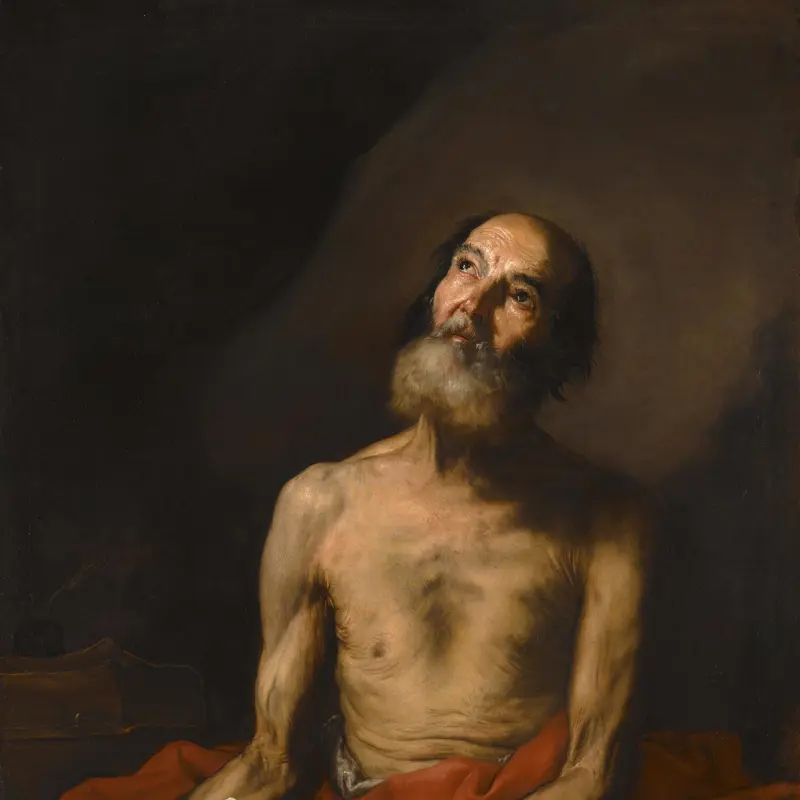Jusepe de Ribera, 'Jacob with the Flock of Laban', probably 1638
About the work
Overview
Jacob sits next to a stream, holding his shepherd’s staff, surrounded by his flock. Resting beneath a tree, he looks up towards heaven as if seeking guidance or strength: according to the Old Testament story, Jacob agreed to tend Laban’s flock for seven years so that he could marry his daughter Rachel. Instead of paying wages, Laban promised Jacob he could keep any speckled lambs that were born. Jacob peeled the bark off wooden branches and placed them in the stream (two are floating lower left). Any sheep that drank from this water would conceive speckled lambs, which Jacob was later able to claim as his own.
A copy after this painting in the Museo Cerralbo, Madrid, reveals that the National Gallery painting was substantially cut down on the left-hand side: the canvas was originally more rectangular in format and included a speckled sheep in the left foreground.
Ribera signed the painting lower right, stating his Spanish nationality, his training at the Academy in Rome and the date 1638.
Key facts
Details
- Full title
- Jacob with the Flock of Laban
- Artist
- Jusepe de Ribera
- Artist dates
- 1591 - 1652
- Date made
- Probably 1638
- Medium and support
- Oil on canvas
- Dimensions
- 132 × 118 cm
- Inscription summary
- Signed; Dated
- Acquisition credit
- Lord Colborne Bequest, 1854
- Inventory number
- NG244
- Location
- Not on display
- Collection
- Main Collection
- Previous owners
Provenance
Additional information
Text extracted from the ‘Provenance’ section of the catalogue entry in Neil MacLaren, revised by Allan Braham, ‘National Gallery Catalogues: The Spanish School’, London 1988; for further information, see the full catalogue entry.
Bibliography
-
1806Mr White, Capital Pictures: A Catalogue of a Genuine and Valuable Collection of Italian, Flemish, and Dutch Pictures, London, 17 April 1806
-
1847British Institution, Catalogue of Pictures by Italian, Spanish, Flemish, Dutch, French and English Masters, with which the Proprietors have Favoured the Institution: June 1847, London 1847
-
1854G.F. Waagen, Treasures of Art in Great Britain: Being and Account of the Chief Collections of Paintings, Drawings, Sculptures, Illuminated Mss. […], vol. 2, trans. E. Eastlake, London 1854
-
1946B. de Pantorba, José de Ribera: Ensayo biográfico y crítico, Barcelona 1946
-
1952Maclaren, Neil, National Gallery Catalogues: The Spanish School, London 1952
-
1958J.A. Gaya Nuño, La pintura española fuera de España: Historia y catálogo, Madrid 1958
-
1970N. MacLaren and A. Braham, The Spanish School, 2nd edn, London 1970
-
1971C.M. Felton, Jusepe de Ribera: A Catalogue Raisonné, Ann Arbor 1971
-
1978N. Spinosa and A.E. Pérez Sánchez, L'opera completa del Ribera, Milan 1978
-
1982C. Felton and W.B. Jordan, Jusepe de Ribera lo Spagnoletto, 1591-1652, (exh. cat. Kimbell Art Museum, 4 December 1982 - 6 February 1983), Fort Worth 1982
-
1983M. Helston, Spanish and Later Italian Paintings, London 1983
-
1988Maclaren, Neil, revised by Allan Braham, National Gallery Catalogues: The Spanish School, 2nd edn (revised), London 1988
-
1991F.B. Doménech, Ribera: 1591-1652, Madrid 1991
-
1995J. Gonçalves, Philippe de Champaigne, le patriarche de la peinture, 1602-1674, Paris 1995
-
2001
C. Baker and T. Henry, The National Gallery: Complete Illustrated Catalogue, London 2001
-
2003N. Spinosa, Ribera, Naples 2003
-
2008N. Spinosa, Ribera: La obra completa, Madrid 2008
About this record
If you know more about this work or have spotted an error, please contact us. Please note that exhibition histories are listed from 2009 onwards. Bibliographies may not be complete; more comprehensive information is available in the National Gallery Library.




